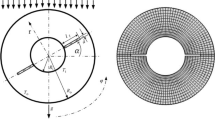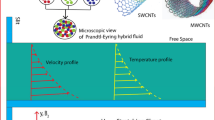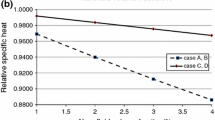Abstract
In the present study, the theoretical and experimental results of the second law analysis on the performance of a uniform heat flux tube using are presented in the laminar flow regime. For this purpose, carbon nanotube/water nanofluids is considered as the base fluid. The experimental investigations were undertaken in the Reynolds number range from 800 to 2600, volume concentrations of 0.1–1 %. Results are verified with well-known correlations. The focus will be on the entrance region under the laminar flow conditions for SWCNT nanofluid. The results showed that the Nu number increased about 90–270 % with the enhancement of nanoparticles volume concentration compared to water. The enhancement was particularly significant in the entrance region. Based on the exergy analysis, the results show that exergetic heat transfer effectiveness is increased by 22–67 % employing nanofluids. The exergetic efficiency is increase with increase in nanoparticles concentration. On the other hand, exergy loss was reduced by 23–43 % employing nanofluids as a heat transfer medium with comparing to conventional fluid. In addition, the empirical correlation for exergetic efficiency has also been developed. The consequential results obtained from the correlation are found to be in good agreement with the experimental results within ±5 % variation.













Similar content being viewed by others
Abbreviations
- MWCNT:
-
Multi wall carbon nanotube
- Cp :
-
Specific heat at constant pressure (J kg−1 K−1)
- di :
-
Inside diameter of the test tube (m)
- f:
-
Friction factor
- h:
-
Heat transfer coefficient (W m−2 K−1)
- K:
-
Thermal conductivity of fluid (W m−1 K−1)
- L:
-
Length of the test section (m)
- m:
-
Flow consistency index (s−1)
- ṁ:
-
Mass flow rate (kg s−1)
- n:
-
Flow behavior index
- Nu:
-
Nusselt number
- Pr:
-
Prandtl number
- ΔP:
-
Pressure drop (Pa)
- T:
-
Temperature (°C)
- s:
-
Entropy
- X:
-
Exergy
- T0 :
-
Environment temperature
- δ:
-
Tape thickness (m)
- ρ:
-
Fluid density (kg m−3)
- μ:
-
Fluid viscosity (kg s−1 m−1)
- ε:
-
Rational efficiency
- ϕ:
-
Volume concentration
- b:
-
Bulk
- nf:
-
Nanofluid
- np:
-
Nanoparticle
- bf:
-
Base fluid
References
Azmia WH et al (2014) Comparison of convective heat transfer coefficient and friction factor of TiO2 nanofluidflow in a tube with twisted tape inserts. Int J Therm Sci 81:84–93
Duangthongsuk W, Wongwises S (2009) Heat transfer enhancement and pressure drop characteristics of TiO2-water nanofluid in a double-tube counter flow heat exchanger. Int J Heat Mass Transf 52:2059–2067
Naika MT et al (2014) Comparative study on thermal performance of twisted tape and wire coil inserts in turbulent flow using CuO/water nanofluid. Exp Therm Fluid Sci 57:65–76
Narvaez JA, Veydt AR, Wilkens RJ (2014) Evaluation of nanofluids as potential novel coolant for aircraft applications: the case of de-ionized water-based alumina nanofluids. J Heat Transf 136(5):1–10
Tiwari AK, Ghosh P, Sarkar J (2013) Heat transfer and pressure drop characteristics of CeO2/water nanofluid in plate heat exchanger. Appl Therm Eng 57:24–32
Chiney A, Ganvir V, Pradip BR (2013) Stable nanofluids for convective heat transfer applications. J Heat Transf 136(2):36–41
Gao Y et al (2013) Effects of soot nanoparticles on heat transfer and flow in fire-tube waste heat boiler. Asia‐Pac J Chem Eng 8(3):371–383
Ferrouillat S et al (2013) Influence of nanoparticle shape factor on convective heat transfer and energetic performance of water-based SiO2 and ZnO nanofluids. Appl Therm Eng 51:839–851
Jamal-Abada MT, Zamzamian A, Dehghan M (2013) Experimental studies on the heat transfer and pressure drop characteristics of Cu-water and Al-water nanofluids in a spiral coil. Exp Therm Fluid Sci 47:206–212
Schio ER, Celli M, Barletta A (2013) Effects of Brownian diffusion and thermophoresis on the laminar forced convection of a nanofluid in a channel. J Heat Transf 136(2):1–8
Hu Y et al (2013) Experimental and numerical investigation on natural convection heat transfer of TiO2-water nanofluids in a square enclosure. J Heat Transf 136(2):68–73
Haghighi EB et al (2014) Experimental study on convective heat transfer of nanofluids in turbulent flow: methods of comparison of their performance. Exp Therm Fluid Sci 57:378–387
Nazaria M, Karami M, Ashouri M (2014) Comparing the thermal performance of water, ethylene glycol, alumina and CNT nanofluids in CPU cooling: experimental study. Exp Therm Fluid Sci 57:371–377
Peyghambarzadeh SM et al (2011) Experimental study of heat transfer enhancement using water/ethylene glycol based nanofluids as a new coolant for car radiators. Int Commun Heat Mass Transf 38:1283–1290
Safarvand D et al (2014) Exergy analysis of NGL recovery plant using a hybrid ACOR-BP neural network modeling: a case study. Asia-Pac J Chem Eng. doi:10.1002/apj.1857
Singh PK et al (2010) Entropy generation due to flow and heat transfer in nanofluids. Int J Heat Mass Transf 53(21–22):4757–4767
Das SK, Roetzel W (1998) Second law analysis of a plate heat exchanger with an axial dispersive wave. Cryogenics 38:791–798
Can A, Eryener D, Buyruk E (1999) Experimental studies on influence of processes variables to the exergy losses at the double tube heat exchanger. In: Kakac S, Bergles AE, Mayinger F, Yuncu H (eds) Heat transfer enhancement of heat exchanger. Kluwer Academic Publishers, London, pp 641–648
San JY, Jan CL (2000) Second-law analysis of a wet crossflow heat exchanger. Energy 25:939–955
Yilmaz M, Sara ON, Karsli S (2001) Exergy performance evaluation criteria for heat exchangers based on second law analysis. Int J 1(4):278–294
Wang SP et al (2003) Exergy destruction due to mean flow and fluctuating motion in incompressible turbulent flows through a tube. Energy 28:809–823
Akpinar EK (2006) Evaluation of heat transfer and exergy loss in a concentric double pipe exchanger equipped with helical wires. Energy Convers Manag 47:3473–3486
Naphon P (2006) Second law analysis on the heat transfer of the horizontal concentric tube heat exchanger. Int Commun Heat Mass Transf 33:1029–1041
Gupta A, Das SK (2007) Second law analysis of crossflow heat exchanger in the presence of axial dispersion in one fluid. Energy 32:664–672
Mahian O et al (2013) A review of entropy generation in nanofluid flow. Int J Heat Mass Transf 65:514–532
Khairul MA et al (2014) Heat transfer performance and exergy analyses of a corrugated plate heat exchanger using metal oxide nanofluids. Int Commun Heat Mass Transf 50:8–14
Pak BC, Cho YI (1998) Hydrodynamic and heat transfer study of dispersed fluids with submicron metallic oxide particles. Exp Heat Transf 11:151–170
Xuan Y, Roetzel W (2000) Conceptions for heat transfer correlation of nanofluids. Int J Heat Mass Transf 43:3701–3707
Maxwell JCA (1881) A treatise on electricity and magnetism, 2nd edn. Clarendon Press, Oxford
Hamilton RL, Crosser OK (1962) Thermal conductivity of heterogeneous two component systems. I&EC Fundam 1:182–191
Yu W, Choi SUS (2003) The role of interfacial layers in the enhanced thermal conductivity of nanofluids: a renovated Maxwell model. J Nanopart Res 5:110–116
Li J (2008) Computational analysis of nanofluid flow in microchannels with applications to micro-heat sinks and bio-MEMS. NC State University, Raleigh
Khanafer K, Vafai K (2011) A critical synthesis of thermophysical characteristics of nanofluids. Int J Heat Mass Transf 54:4410–4428
Azmia WH et al (2013) Experimental determination of turbulent forced convection heat transfer and friction factor with SiO2nanofluid. Exp Thermal Fluid Sci 51:103–111
Corcione M (2010) Heat transfer features of buoyancy-driven nanofluids inside rectangular enclosures differentially heated at the sidewalls. Int J Therm Sci 49:1536–1546
Bird RB, Stewai WE, Lightfoot EN (2002) Transport phenomena, 2nd edn. Wiley, New York
Rastogi R et al (2008) Comparative study of carbon nanotube dispersion using surfactants. J Colloid Interface Sci 328:421–428
Coleman HW, Steele WG (1989) Experimental and uncertainty analysis for engineers. Wiley, New York
Shah RK (1975) Thermal entry length solutions for the circular tube and parallel plates. In: Proceedings of third national heat mass transfer conference. Indian Institute of Technology, Bombay
Incropera FP et al (2006) Fundamentals of heat and mass transfer. Wiley, New York
Author information
Authors and Affiliations
Corresponding author
Appendix: Uncertainty analysis
Appendix: Uncertainty analysis
To examine the accuracy of the results, an uncertainty analysis was carried out using the theory of the propagation of error; the uncertainty UF on a quantity F which is function of x1,…xn, measured variables with an associated uncertainty Uxi can be expressed as follows:
And the relative uncertainty δF is:
The uncertainty table for different instruments used in experiment is given in Table 2. The maximum possible error for the parameters involved in the analysis are estimated and summarized in Table 3.
Reynolds number, Re:
Heat Flux:
Heat transfer coefficient, h:
Nusselt number, Nu:
Friction factor, f:
Rights and permissions
About this article
Cite this article
Hazbehian, M., Mohammadiun, M., Maddah, H. et al. Analyses of exergy efficiency for forced convection heat transfer in a tube with CNT nanofluid under laminar flow conditions. Heat Mass Transfer 53, 1503–1516 (2017). https://doi.org/10.1007/s00231-016-1915-1
Received:
Accepted:
Published:
Issue Date:
DOI: https://doi.org/10.1007/s00231-016-1915-1




